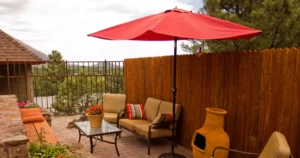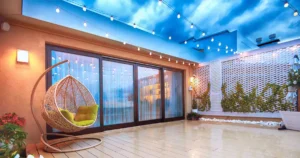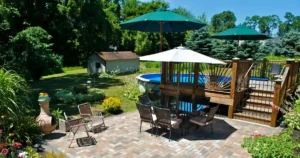Deciding on the perfect wood outdoor table tops for your backyard or patio can feel super intimidating at first. With so many options to choose from, it’s easy to end up more confused than when you started! However, finding the right wood table tops is seriously important if you want your outdoor space to feel welcoming and functional for hosting friends.
This guide has all the details on picking wood table tops that are just right for the outdoors. I’ll cover things like how different wood varieties hold up against rain and sun, what kind of maintenance they’ll need, the stylish options for shapes, plus insider tips. By learning more about this topic, you’ll be able to make a decision that feels right for you. All the important information will be there for you to carefully consider your options. Taking the time to understand the issues can help ensure you end up choosing a path that truly fits your needs and priorities.
So, kick back, relax, and read on. I’m going to break it down simply, so you can gain confidence selecting wood table tops that are perfectly tailored to your space. No more stress – by the end, you’ll be ready to curate your dreamy outdoor oasis!
Factors to Consider When Choosing Wood for Outdoor Table Tops
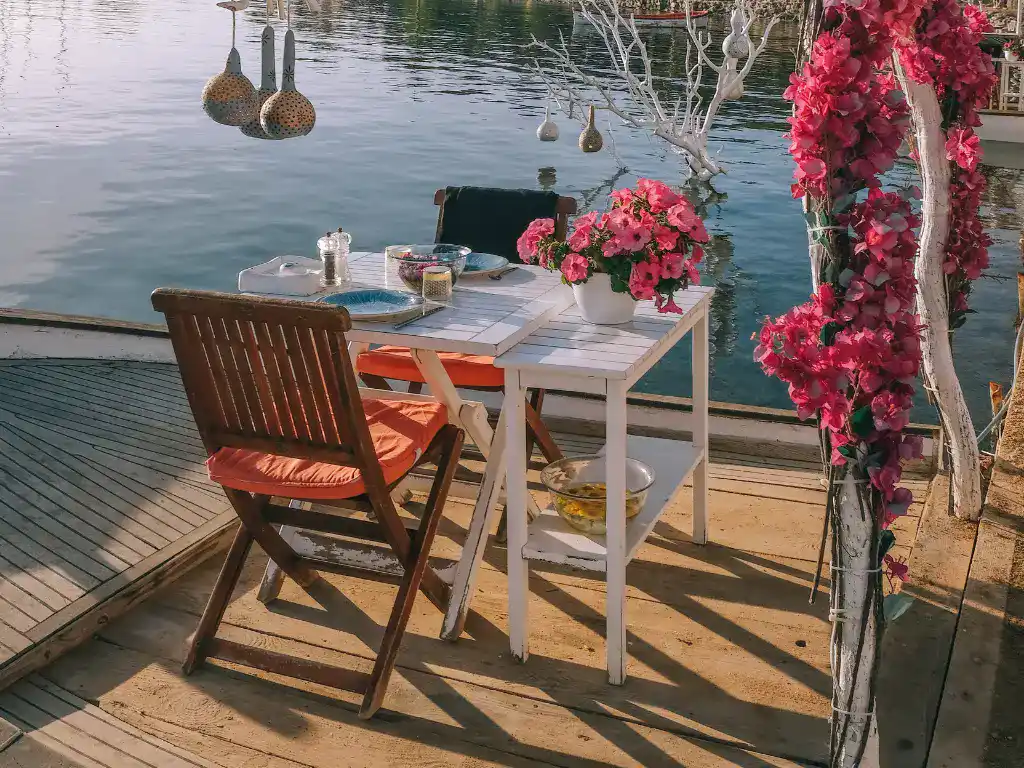
Weather Resistance
The number one factor when choosing wood outdoor table tops is finding wood varieties that can withstand the elements. As outdoor tables are exposed to sun, rain, snow, and fluctuating temperatures, the ideal woods are those with natural weather resistance or those that are treated for outdoor use. Consider these factors when assessing wood’s weather durability:
- Density and Oil Content: Woods like teak, Ipe, and white oak have a dense grain and natural oils that make them water-resistant. The tight grain doesn’t allow water to penetrate easily, while the oils repel moisture. These naturally weather-resistant woods are ideal for outdoor tables.
- Heartwood vs Sapwood: The living outer portion of a log is called sapwood, while the heartwood is the inner matured section. For outdoor use, the heartwood is more durable as the dense heartwood resists decay. Sapwood is more porous and prone to rotting.
- Treatment for Outdoor Use: Many wood types can be treated with stains, sealants, or preservatives to improve weather resistance. Common treatments include varnish, polyurethane, oils, and water-repellent preservatives with fungicides. Pressure-treated woods are infused with chemicals like copper azole to resist rot and insects.
Maintenance Needs
Some woods, like teak, require little maintenance beyond occasional cleaning to look their best outside. Others may need re-oiling or re-sealing every year or two to maintain their finish. Consider how much upkeep you are willing to do to keep your wood table tops looking pristine. Lower-maintenance woods are ideal for set-and-forget use.
Style and Aesthetics
The style you envision for your outdoor space should guide your wood choice. Rustic woods like pine or acacia fit farmhouse vibes, while sleek teak and mahogany suit contemporary spaces. Also consider:
- Color: Woods range from warm brown tones to reddish hues and pale blonde shades of acacia or ash. Choose a wood that complements your color palette.
- Grain Patterns: The flowing grain of acacia or maple creates visual interest, while teak offers a straight, consistent grain. Distressed wood adds rustic charm.
- Knots: Some woods display small knot formations, which can enhance the natural appeal. Avoid knotty pine if you prefer an unblemished look.
- Finish Options: From smooth sanded finishes to live-edged slabs, consider the look you want from your wood’s surface and cut.
Ideal Wood Types for Outdoor Tables
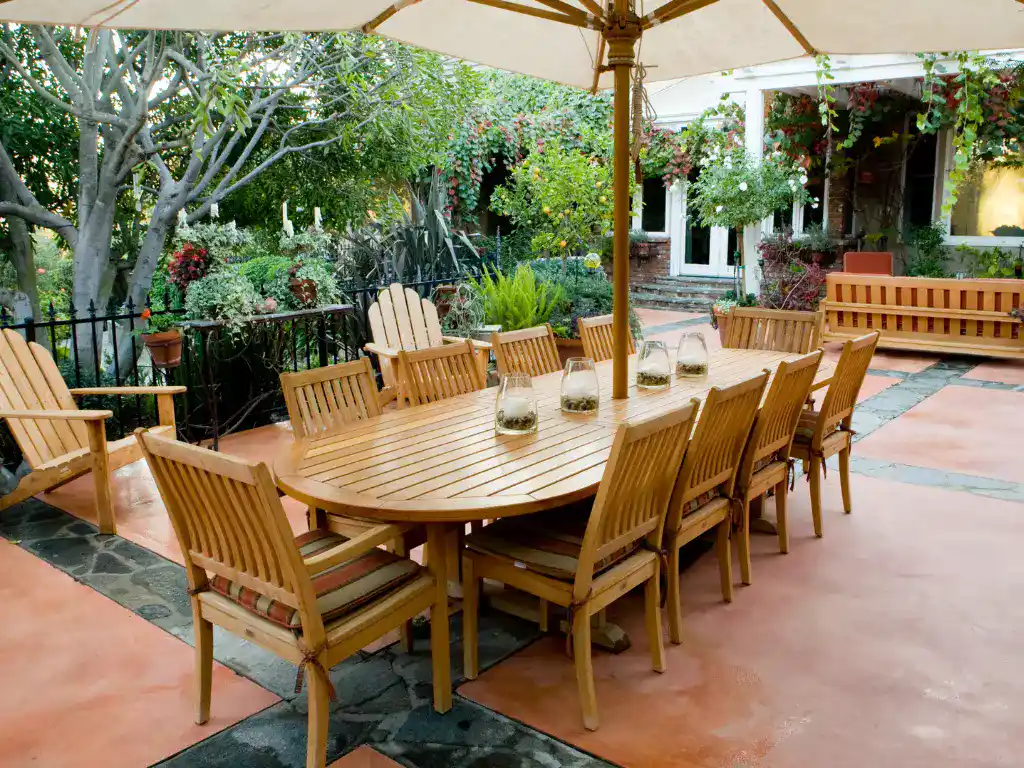
Here are the best wood varieties for outdoor tables and their key characteristics:
- Teak – This tropical hardwood has a high oil content, making it exceptionally weather-resistant with little upkeep needed. It offers a straight, consistent grain in blonde to dark brown hues. If your teak or other wood furniture needs repairs over time, check out this post on How to restore teak outdoor furniture.
- Ipe – Also called Brazilian walnut, Ipe is dense and nearly waterproof. It has a dark brown/black coloring and naturally resists rot, mold, and insects. Its hardness makes it extremely durable but difficult to work with.
- White Oak – A popular domestic hardwood, white oak has a mildly weather-resistant finish. It machines well for furniture making and has an attractive light brown hue with occasional knots.
- Cedar – An aromatic softwood that’s naturally resistant to decay and insects. It has a reddish-brown tone and straight or knotty grain. Crafting with cedar is a real pleasure – it cuts, shapes, and finishes beautifully. And though it offers outstanding durability for the value, you’ll find cedar’s prices are sensible enough for most any budget.
- Redwood – Another rot-resistant softwood with a reddish color. It is moderately durable outside and is workable for shaping table tops. Has low tannins (unlike cedar) so it won’t stain surfaces.
- Eucalyptus – An imported hardwood gaining popularity for outdoor use. The dense eucalyptus has variegated red-brown hues with rustic grain patterns. It is durable when oiled and resists moisture.
- Mahogany – A classic rich reddish-brown wood that takes oil or varnish well. It has good moisture and insect resistance. More affordable options include Luan or Philippine mahogany.
- Acacia – This sustainable tropical hardwood has gained favor for outdoor furniture. It is dense and durable with an attractive, varied grain in light brown tones. Environmentally certified acacia is not endangered.
- Maple – Hard maple is moderately weather resistant, while soft maple requires more protection. Offers light tan coloring and finely grained texture ideal for smooth finishes. The hardness of maple makes it durable.
- Alder – Inexpensive and abundant in North America, alder machines well and takes finishes evenly. It has a light tan hue that darkens slightly outside. Resins help protect against moisture and require moderate maintenance.
- Pine – An affordable softwood suitable for treated outdoor use, though not naturally durable. Desirable knotty appearance and golden hue when finished. Use pressure-treated pine out of longevity concerns.
For more details on the characteristics of different wood varieties, check out The Spruce.
Shape Considerations for Wood Outdoor Table Tops

The shape of your outdoor table tops impact functionality. Consider:
- Rectangular – The most common table shape works well for most spaces. Offers a roomy surface area.
- Round – A round table allows equal seating access from all sides and encourages conversation. Round is better for compact settings.
- Square – Like rectangular tables, square tables maximize tabletop space efficiently. The blocky shape provides a modern touch.
- Oval or Elliptical – An elongated rounded shape saves room versus a circle table. An oval can fit more people than a circle shape.
- Custom Shapes – For a built-in look, have table tops cut to fit your exact outdoor living space, like around a tree.
- Freeform – Organic table shapes with curved edges add a natural, whimsical feel to outdoor spaces.
Size Factors for Wood Outdoor Table Tops
Consider the dimensions of your existing space and seating needs when selecting a suitable table size:
- Seating – Allow 24-30 inches per seat for comfortable spacing. Benches lined along table sides can slightly reduce space per seat.
- Circulation Area – Allow ample room around the table for people pulling out chairs and walking around the table. At least 36 inches surrounding is ideal.
- Space Proportions – Scale your table size appropriately to your deck, patio, or backyard space. Measure to find the ideal footprint that fits without dominating.
- Storage Space – Larger tables like 10-foot banquets may need dedicated storage space when not in use. Ensure you have space for off-season storage.
- Weight Load – Check the capacity of your table to hold plates, glasses, serving dishes, and occupants. Select substantial wood and legs that can support the weight.
Mix-and-Match Options
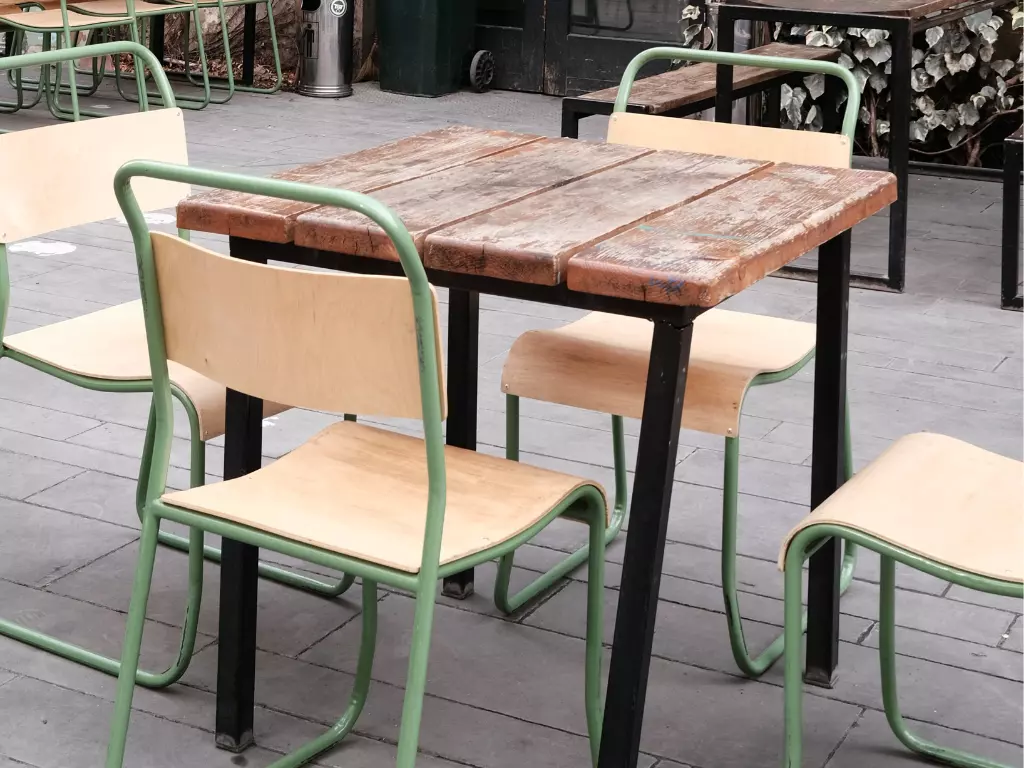
Outdoor tables don’t necessarily need to match coordinating chairs. Consider mix-and-match wood elements:
Wood Table Top
Choose your preferred table wood for weather resistance and style.
Different Leg Material
Pair your wood top with powder-coated steel or aluminum legs for a contrasting look.
All-Weather Chairs
Acrylic, resin, or waterproof padded chairs withstand the elements around a wood table.
Same Wood, Different Style
An industrial wood plank table could match rustic acacia chairs. Varying wood tones and table/chair styles can complement each other.
Accessories
Weather-proof ceramic table with matching live-edged benches. Accent with coordinating planters or side tables.
Ideal Wood Finishes for Outdoor Table Tops
The right protective finish helps safeguard your wood against moisture, UV rays, fungus, and pests:
- Polyurethane – A popular water-resistant finish that maintains the natural look of wood. Helps prevent staining and fading. Reapply every 1-2 years.
- Penetrating Oil – Oils like Tung oil penetrate wood pores without forming a surface layer. Accentuates wood grain and needs annual reapplication.
- Spar Varnish – Formulated for exterior use on boats and furniture. Offers superior UV protection to polyurethane with a transparent sheen.
- Painted Finishes – Painted wood tables should be primed first, and then painted with exterior-grade paint. This adds a protective finish and allows for color customization.
- Stain – Semi-transparent exterior wood stains enhance the wood grain while protecting it. Balance wear and reapplication needs.
- Teak Oil – The oil extracted from teak wood nourishes and protects other less-oily woods. It must be reapplied regularly, up to four times per year.
- Epoxy – Used on live-edge slab tables, epoxy fully seals and coats the wood’s cut edges against moisture intrusion. Requires skill to apply properly.
Common Woods to Avoid for Outdoor Tables Tops
Steer clear of these woods that are not suitable for long-term outdoor exposure:
- Plywood – Plywood is not very durable outside as it can absorb moisture between its layers, resulting in delamination over time.
- Softwoods like pine (except pressure treated) – Pine is generally not very rot resistant on its own unless pressure treated. The soft texture makes it susceptible to weather damage.
- Western red cedar – While aromatic cedar is popular for indoor uses, its lightweight structure does not hold up well against weather long term.
- Poplar – This inexpensive hardwood lacks durability when exposed continuously to moisture and sunlight. It is better suited for indoor or transitional outdoor spaces.
- Mahogany (not Philippine or African mahogany) – Traditional mahogany is not very resistant to rot and insects compared to harder tropical mahoganies.
Tips for Maintaining Wood Outdoor Tables
Some simple techniques will keep your wood tables looking fresh:
- Wipe up any spills ASAP so they don’t stain or cause moisture damage.
- Give your table a light cleaning once a month using something gentle like white vinegar or hydrogen peroxide diluted in water.
- If you notice little splinters or cracks starting to form, sand them down before reapplying your sealant.
- Stick to a yearly resealing or reapplying schedule before things start looking weathered.
- Keep cushions, clothes, etc. stored nicely when not in use to make them last.
- Consider seasonally protecting from the sun with an umbrella, clothes, or pergola during harsh months.
- Every so often, flip or rotate wood panels to prevent uneven fading over time.
With the right wood choice and protection, your outdoor table can withstand countless cookouts and hangouts with friends and family through many outdoor seasons. Selecting a durable wood variety and caring for it properly ensures your backyard investment stands the test of time.
Final Thoughts on Choosing Wood Outdoor Table Tops

Picking out the perfect wood for your outdoor table tops is no easy feat. There are so many factors to consider like weather resistance, how much maintenance they’ll need, and finding a style you love. But don’t stress – with the right wood variety and protections, your outdoor wood table tops can stand the test of time while looking gorgeous too.
Teak, Ipe, and white oak are legendary for being super durable outdoors. But don’t sleep on other sustainable hardwoods like acacia – they’re really coming up these days too. No matter what type of wood you choose, keeping up with regular cleanings and reapplying sealers will help your wood table tops stay in tip-top shape for years of cookouts and cocktails under the stars.
With the tips provided in this guide, you can confidently pick wood table tops that suit your style and withstand everything your outdoor space throws at them. Once you pick out wood table tops that jive with your space and lifestyle, follow the care instructions to preserve that beautiful finish. Your friends and family will be wowed for seasons to come thanks to your lovely wood outdoor table tops oasis. Dive in – choosing wood table tops you’ll adore is totally within reach.
Frequently Asked Questions (FAQs)
Q: How often should I reseal or restrain my wood table top?
This depends on the wood and finish used, as well as your local climate conditions. Most finishes will last 1-2 years with regular cleaning before needing to be reapplied. Hardwoods like teak may only need reoiling once per year. Consult the product instructions or ask a paint store for recommendations.
Q: Can I leave my wood table outside all year?
Yes, many wood varieties are durable enough to withstand year-round outdoor use with proper maintenance. However, consider bringing tables indoors before and after extreme winter/summer seasons to prolong their lifespan further. You may also use seasonal tablecloths or covers for sun protection.
Q: What’s the best way to clean wood table tops outdoors?
The gentlest method is to wipe surfaces down monthly with a mild cleaner and soft cloth or brush. White vinegar or hydrogen peroxide diluted in water works well without damaging sealed finishes. Avoid abrasive cleaners. For ground-in dirt, lightly sand then reapply your protective sealer.
Q: Maintaining a wood table sounds like a lot of work. Is it really worth it?
I know outdoor upkeep can feel like a chore. But having a beautiful wood table is so worth it on those summer nights spent dining al fresco with friends! With the right wood like teak, maintenance is minimal too. And there’s nothing better than relaxing at a table that feels like a natural extension of your outdoor oasis. Embrace those cozy moments – they make all the cleaning worthwhile.
Q: What if my table gets weathered differently in some spots? Is that okay?
Totally normal! No need to stress about uneven aging – it just adds character. Wood is a natural material that reacts differently depending on sunlight exposure. Over time, surfaces may darken more on one side. The good news is a little weathering only enhances rustic appeal. Embrace imperfections and enjoy your patina-ing table! No one will notice small variations but you. Relax and let nature take its artistic course.
Q: Can I put a table umbrella on my wood table?
Using an umbrella is a smart way to protect wood from sun damage. Just be sure to choose an umbrella designed for outdoor furniture use. The joints shouldn’t leak or allow water to pool on the table. And use an umbrella base that doesn’t damage the surface. With the right protective equipment, your wood table can handle all the sun and rain your umbrella deflects. Go ahead and stay cool – your table will stay happy too!



